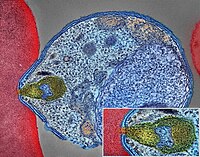
Photo from wikipedia
Paenarthrobacter aurescens (formerly called Arthrobacter aurescens) strain TC1 is a high G + C Gram-positive aerobic bacterium that can degrade the herbicide atrazine. Analysis of its genome indicated strain TC1 has the… Click to show full abstract
Paenarthrobacter aurescens (formerly called Arthrobacter aurescens) strain TC1 is a high G + C Gram-positive aerobic bacterium that can degrade the herbicide atrazine. Analysis of its genome indicated strain TC1 has the potential to form a bifunctional PutA protein containing l-proline dehydrogenase and l-glutamate-γ-semialdehyde dehydrogenase (l-Δ1-pyrroline-5-carboxylate dehydrogenase) activities. P. aurescens strain TC1 grew well in minimal media with l-Proline as a supplemental nutrient, the nitrogen source, or the sole carbon and nitrogen source. Multicellular myceloids induced by NaCl or citrate also grew on l-proline. The specific activity of l-proline dehydrogenase in whole cells was higher whenever l-proline was added to the medium. Both l-proline dehydrogenase and l-glutamate-γ-semialdehyde dehydrogenase (l-Δ1-pyrroline-5-carboxylate dehydrogenase) activities were found primarily in a membrane fraction from exponential-phase cells. The two activities co-eluted from a Bio-Gel P-60 column after precipitation of proteins with ammonium sulfate and solubilization with 0.1% Tween 20. The PutA protein in the active fraction also oxidized 3,4-dehydro-dl-proline, but there was no activity with other l-proline analogues. When P. aurescens strain TC1 was grown in minimal media containing increasing concentrations of NaCl, there was a progressive decrease in the specific activity of l-proline dehydrogenase and a concomitant increase in the intracellular concentration of l-proline. These results indicate that P. aurescens strain TC1 can use l-proline as a nutrient in a regulated fashion. Because this bacterium also showed the ability to degrade most of the other common amino acids, it can serve as a useful model for the control of amino acid catabolism in the high G + C Actinobacteria.
Journal Title: Antonie van Leeuwenhoek
Year Published: 2018
Link to full text (if available)
Share on Social Media: Sign Up to like & get
recommendations!